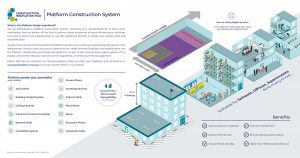Building envelope manufacturers SFS and the Construction Innovation Hub discuss how they are using ‘platforms’ to bring about construction innovation. Learning from other manufacturing sectors is the key to making this a reality
The challenges facing the construction industry are well documented and age-old. First, there’s the wastage of both time and resources – more often than not frontline workers are waiting for materials to be delivered, while stock already at site gets lost, stolen or damaged.
Then there’s the fragmentation. With different stakeholders getting involved at every level, decision-making is slow and, more often than not, projects boil down to costs. And this slowness isn’t just limited to project progress either – the traditional construction model is cumbersome, and real change is hard to implement.
All the while, skills are disappearing faster than ever. An ageing workforce and not enough
young people joining construction is signalling a challenging time ahead for our industry.
Yet building and infrastructure is vital to our economy and our recovery from this pandemic, which the government recognises and is investing in. We’re two years into a 10-year programme where over £600bn of government investment is expected.
There appears to be no slowdown expected either, despite the pandemic. If anything,
resolve is now stronger than ever before, with “building back better” the slogan on
everybody’s lips. In June, analysis of the National Infrastructure & Construction
Procurement Pipeline, it sets out that up to £37bn of planned procurement is expected
between 2020-21, with 340 procurements across 260 projects and programmes.
To deliver on this expectation, the industry knows it has to change – and change fast. To this end, SFS is one of the key partners involved in the Construction Innovation Hub’s Platform Design Programme, designed to deliver revolutionary change in the coming years.

Platforms for success
Today, carmakers can freely share subassemblies like the floor pan, drivetrain, suspension
and axles between each other. This greatly reduces cost and complexity, allowing more
flexibility to scale and “chop and change” options based on this method. So why can’t the
construction industry adopt a similar philosophy?
The Construction Innovation Hub is now making this a reality through its Platform Design Programme. Looking at digital tools and Modern Methods of Construction (MMC), the Hub is blending expertise from a range of organisations.
These include the Manufacturing Technology Centre (MTC), the Centre for Digital Built Britain (CDBB) and the Building Research Establishment (BRE), along with government partners and industry specialists like SFS.
Elements of buildings will be broken down into subassemblies, which include:
- Active roof.
- Building control system.
- Ceiling cassette.
- Cores (including vertical circulation).
- External walls.
- Foundation system.
- Ground floors.
- Incoming services.
- Internal walls.
- Plant room.
- Risers.
- Structural frame.
- Volumetric pods.
Sitting on the structural frame, active roof and external wall groups, SFS is already using its long heritage in partnering with organisations to advance technology to the benefit of the industry, and indeed our brand stands for “Inventing success together”.
Andy Stolworthy, director of product and market development for SFS, commented: “The
Platform Design Programme will drive transformation in the construction industry, it’s the
kind of project that fits SFS’s DNA perfectly.
“We are working with like-minded partners in the industry, developing new tools and methods of construction. Knowing you are part of something that will shape the future is exciting, not only are we looking forward to the outcome but what we will learn on the journey.”
Trudi Sully, impact director – manufacturing at the Construction Innovation Hub, added:
“The Construction Innovation Hub’s mission is to act as a catalyst for transformation in the
sector. The only way we can do that successfully is with the involvement and engagement of our vital delivery partners such as SFS.
“These pioneering companies have recognised the benefits of collaboration to drive
innovation and are grabbing the bull by the horns on the Platform Design Programme.
“SFS’s forward-thinking approach is truly reflective of the culture we have in the Hub and will play an integral role in our mission to deliver true value driven change in how we deliver our social infrastructure needs.”
The next steps to construction innovation
The Hub’s Platform Design Programme is already on the road to delivering a construction
system that will use a standardised kit of parts to form the next wave of public sector
building programmes.
This will be done by determining the needs for these buildings and
incorporating them in the Platform specification and development of the designs.
Progress has been fast, with research conducted with government departments and
industry partners already showing initially, the best type of building for a platform-based
approach has:
- Floor to ceiling heights of up to 3m.
- Floor spans of no more than 9m or 12m.
- Up to four storeys with scope to fulfil higher rise requirements.
- Flexible usage.
In terms of next steps, the specification requirements are finalised, which enables the participants to move from the conceptual stage to the actual design stage.
Alongside this, tools are being developed to facilitate platform use in wider construction, such as the Construction Quality Planning (CQP) guide, which is key to delivering one of the core themes: Assurance. The ultimate goal will be for these tools to be available and validated along with the proof-of-concept platform building in Q4 2022.
A roadmap to construction success
The UK’s construction industry is at a crucial, defining point in its history. With hundreds of
billions of pounds to be spent on infrastructure in the next 10 years, it is vital that this
money is not wasted and that our buildings deliver better experiences where our people,
and our economy, can thrive.
As the Construction Innovation Hub put it, the benefits to a platform-based approach are varied and include:
- Improved assurance of buildings.
- Increase whole life value.
- Improved health and safety.
- Reduction in delivery time.
- Reduced greenhouse gas emissions.
- Higher level of lifetime build performance.
At SFS, we look forward to what’s to come, and bringing about true construction innovation.
For more about SFS, please visit www.sfsintec.co.uk.
You can also follow Andy’s blog here or by visiting the Construction Innovation Hub website.
SFS
Tel: +44 (0)330 0555 888
uk.info@sfs.biz
www.sfsintec.co.uk
Twitter: sfsintec
Please note: this is a commercial profile.














